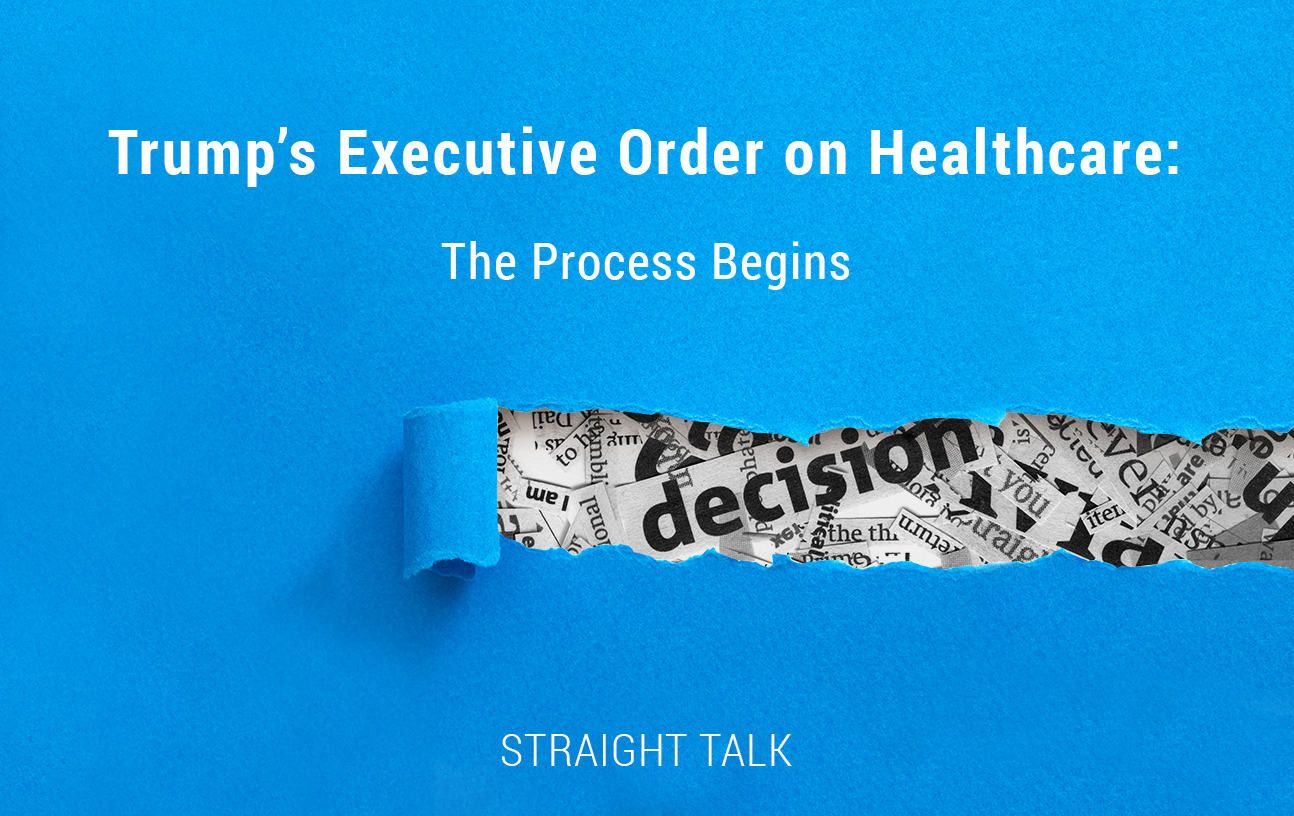Last week, I took a well-deserved vacation. As I perched on the balcony of a nice condo on a balmy October day, enjoying an amazing view of the Gulf of Mexico and people below swimming, sunning and playing, my phone started going crazy. I mean crazy.
Along came the Twitter alerts.
For those of you who are wonky enough to follow me on Twitter (@mikebertaut), you know there are only two real topics in my group of around 400 followers: football and healthcare reform.
It was the healthcare reform group sounding off on this warm Monday (are you sure it’s October?).
BEEP! BEEP! BEEP! BEEP! The tweets were pouring in. It started Monday and didn’t really stop until, well, it’s still rocking today. What activated all this hullabaloo?
On Oct. 12, President Trump issued an Executive Order to three federal agencies—Internal Revenue Service (IRS), Department of Labor (DOL) and Center for Medicaid & Medicare Services (CMS)—to do some stuff.
Before we talk specifically about what he told them to do, let’s talk about this regulatory process a bit.
Room for Interpretation
Now that the President has issued this Executive Order, the agencies are directed to start writing proposed rules to bring about the intentions expressed in the executive order (see below). Just like when you tell your kids to do something, there is ALWAYS room for interpretation. This regulatory and rulemaking process will determine how much these rules end up looking like how the president thinks they should.
Proposed rules are published and then put out for comment. Any concerned party in the United States has the right to send in comments on these rules, and the agency is supposed to read them all, pluck out the really relevant comments and use them to justify how its policy staff wrote the rules.
Sometime later, the agencies will close this comment period and create an Interim Final Rule (IFR). This IFR will also allow a short time for comments. Once this comment period closes, the rules will move from IFR to Final Rules and be published on a massive website called the Federal Register.
Once the rules are published there, they are the law of the land. Any legal challenges to these rules could start immediately once final rules are published. It’s unclear yet whether or not the three agencies will collaborate on the requests and come out with essentially the same rule three times, or go their own way. Typically, government agencies try to speak with one voice to avoid a lot of confusion.
I would guess the process in this case will take anywhere from three to six months. We certainly won’t have these final rules in place in time for the upcoming Open Enrollment (Nov. 1-Dec. 15, 2017).
So Mike, what’s all the hoopla about?
The Executive Order instructs the agencies to consider changing the current rules in three specific areas:
- Association Health Plans—to create some sort of legal protection for companies with no real affiliation to band together across state lines and create a type of pseudo-entity to buy health insurance as a group. The assumption is that this bigger group will be cohesive enough to create a stable, single health plan for a larger pool of people.
- Short-Term, Limited Duration Health Plans—to extend from 90 days to 364 days the time limit a person can keep certain types of “health insurance” (I use the term loosely). The ACA allowed the sale of health plans that could be renewed in 90-day increments for employees waiting to become eligible for employer health plans, or for people in the country for a short period of time. There are almost no rules on the books about what these plans have to cover. Plans like this didn’t count as Minimum Essential Coverage toward satisfying your Affordable Care Act Individual Mandate obligation on your taxes. But, look for this definition to expand, a lot.
- Health Reimbursement Arrangements and Individual Coverage—the IRS recently closed a loophole in the tax law that allowed certain arrangements for people to buy individual health insurance and get a break on their taxes. This order seems to want to reverse that decision and create a path whereby individuals could use pre-tax money to pay their premiums on their health insurance, even outside of a company group plan, which is not possible today.
Each of these proposals has its own strengths and weaknesses. Some are more workable than others. Some have been tried in the past and failed miserably and spectacularly. But you can rest assured we’ll examine each of these proposed changes in detail in upcoming blog posts well before any final rules come out, you’ll already have the Straight Talk on each of them!
Exciting times in healthcare, as usual.





BEEP! BEEP! BEEP! I have some Straight Talk for you. Premiums charged on individual family plans are out of control. Those caught in the middle cannot sustain these unprecedented annual increases much longer My husband was a small business owner, and we have paid for a family plan individually for many, many years. Let me begin my rant by saying, Blue Cross has been and continues to be a great provider and we have been very happy with their processing of our medical claims. Years ago when Obamacare came to be, we were skeptical of the new exchange and opted to keep our existing plan and be “grandfathered” into the system. We continue to have that same plan today. THANK GOD as I can barely afford the grandfathered premium; don’t know what I would do if I had to pay the higher premium through the current exchange system. I guess we just wouldn’t have insurance. When my husband became disabled due to cancer a few years ago and was unable to work, we had to pay for our health insurance ($1,800/mo with $5,600 deductible) with his small disability check and also use our personal line of credit. When I researched how much our premium would be if we changed to the Obamacare exchange, it was a substantial amount more monthly with a higher deductible. How does this help the middle class? It doesn’t. My husband passed away recently, and I was able to pay off the LOC financed health premiums with life insurance proceeds. Each year, I fear receiving “that letter” from Blue Cross where it starts off referencing all of the new coverages that have been added and ends with “we are raising your premium because of these new coverages coupled with the rising cost of health care.” (Translation: You have to pay for all the people who can’t pay for their health insurance. Pretty soon, I’m gonna be one of those people!). It was and continues to be our largest monthly bill, and there is something seriously wrong with that. A recent example: My sweet neighbor, small business owner, has an individual family Blue Cross plan through the Obamacare exchange. Over the past few years, his monthly family premium went from $1,300 to $2,600 and his recent notification last week indicates this year it will be OVER $3,000 a month with very high deductible !!! $43,000+ per year for family health insurance. Bless his heart, he was literally sick to his stomach when he read the letter as he won’t be able to afford to send his three young kids to a private school as he has worked so hard to do. He’s now contemplating selling his small company and finding a job that offers health insurance as a benefit. Health insurance is slowly strangling the life out of the American Dream. I don’t know what the answer is and I know these mounting consumer frustrations apply to all health care insurers, not just Blue Cross (sorry to pick on Blue Cross, but it does say to “Leave A Comment” lol). Health care is continuing to head in the wrong direction and the current system benefits only the poor by putting an extreme financial burden on the working middle class. With that said, how are Blue Cross lobbyists aiding Congress and the Trump Administration in their effort to find a solution to this out of control increasing health premium epidemic? Please leave a comment. Thank you.
Teri!I completely agree with you. The Feds have done a LOUSY job of policing, creating and controlling this individual health insurance market they have created. We are constantly bombarding DC and our reps to make changes that will stabilize this market and not make it worse than it already is, but when it comes to the individual market, they are not listening to us.
When we ask for they money the Act promises to our members from the Feds, they accuse us of wanting “Bailouts” and cut the money off. I’m sorry to say, the individual market here (as you well know) is still challenged.
There are too many things in the rules keeping young people out. Without them, older folks (like me!) premiums are skyrocketing. Soon the Individual Market in Louisiana on the exchange will just be a federally funded high risk pool for people who get assistance, and way too expensive for the people that don’t.
I promise you this: We will never stop teaching, preaching, and defending your right to affordable health care in DC, even if the politicians continue to ignore us and you. I promise you that.
God bless you! Please reach out to me if I can help in any way!…mrb
Also, it is worth noting, many, many, many small business owners have moved from the Individual health insurance market to the Group health insurance market, and it is WELL worth the transition if you have a couple of employees. Group insurance is tax deductible, premiums can be paid with pre-tax dollars, and the rates there are going up at a much slower pace than in the dysfunctional DC-regulated individual market. Especially if your income is over 400% of FPL.